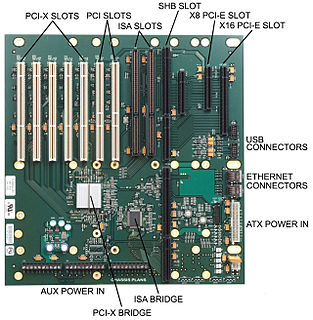
Accelerated Graphics Port (AGP) is a parallel expansion card standard, designed for attaching a video card to a computer system to assist in the acceleration of 3D computer graphics. It was originally designed as a successor to PCI-type connections for video cards. Since 2004, AGP has been progressively phased out in favor of PCI Express (PCIe), which is serial, as opposed to parallel; by mid-2008, PCI Express cards dominated the market and only a few AGP models were available, with GPU manufacturers and add-in board partners eventually dropping support for the interface in favor of PCI Express.

A backplane is a group of electrical connectors in parallel with each other, so that each pin of each connector is linked to the same relative pin of all the other connectors, forming a computer bus. It is used as a backbone to connect several printed circuit boards together to make up a complete computer system. Backplanes commonly use a printed circuit board, but wire-wrapped backplanes have also been used in minicomputers and high-reliability applications.

Industry Standard Architecture (ISA) is the 16-bit internal bus of IBM PC/AT and similar computers based on the Intel 80286 and its immediate successors during the 1980s. The bus was (largely) backward compatible with the 8-bit bus of the 8088-based IBM PC, including the IBM PC/XT as well as IBM PC compatibles.

A motherboard is the main printed circuit board (PCB) in general-purpose computers and other expandable systems. It holds and allows communication between many of the crucial electronic components of a system, such as the central processing unit (CPU) and memory, and provides connectors for other peripherals. Unlike a backplane, a motherboard usually contains significant sub-systems, such as the central processor, the chipset's input/output and memory controllers, interface connectors, and other components integrated for general use.

In computing, PC Card is a configuration for computer parallel communication peripheral interface, designed for laptop computers. Originally introduced as PCMCIA, the PC Card standard as well as its successors like CardBus were defined and developed by the Personal Computer Memory Card International Association (PCMCIA).

In computing, an expansion card, also known as an expansion board, adapter card or accessory card, is a printed circuit board that can be inserted into an electrical connector, or expansion slot, on a computer motherboard, backplane or riser card to add functionality to a computer system via the expansion bus.

PCI Express, officially abbreviated as PCIe or PCI-e, is a high-speed serial computer expansion bus standard, designed to replace the older PCI, PCI-X and AGP bus standards. It is the common motherboard interface for personal computers' graphics cards, hard disk drive host adapters, SSDs, Wi-Fi, and Ethernet hardware connections. PCIe has numerous improvements over the older standards, including higher maximum system bus throughput, lower I/O pin count and smaller physical footprint, better performance scaling for bus devices, a more detailed error detection and reporting mechanism, and native hot-swap functionality. More recent revisions of the PCIe standard provide hardware support for I/O virtualization.

Serial ATA is a computer bus interface that connects host bus adapters to mass storage devices such as hard disk drives, optical drives, and solid-state drives. Serial ATA succeeded the earlier Parallel ATA (PATA) standard to become the predominant interface for storage devices.

ExpressCard, initially called NEWCARD, is an interface to connect peripheral devices to a computer, usually a laptop computer. The ExpressCard technical standard specifies the design of slots built into the computer and of expansion cards to insert in the slots. The cards contain electronic circuits and sometimes connectors for external devices. The ExpressCard standard replaces the PC Card standards.

In computing, a POST card is a plug-in diagnostic interface card that displays progress and error codes generated during power-on self-test (POST) of a computer. It is used to troubleshoot computers that do not start up.

Automatic test equipment or automated test equipment (ATE) is any apparatus that performs tests on a device, known as the device under test (DUT), equipment under test (EUT) or unit under test (UUT), using automation to quickly perform measurements and evaluate the test results. An ATE can be a simple computer-controlled digital multimeter, or a complicated system containing dozens of complex test instruments capable of automatically testing and diagnosing faults in sophisticated electronic packaged parts or on wafer testing, including system on chips and integrated circuits.
PC/104 is a family of embedded computer standards which define both form factors and computer buses by the PC/104 Consortium. Its name derives from the 104 pins on the interboard connector (ISA) in the original PC/104 specification and has been retained in subsequent revisions, despite changes to connectors. PC/104 is intended for specialized environments where a small, rugged computer system is required. The standard is modular, and allows consumers to stack together boards from a variety of COTS manufacturers to produce a customized embedded system.

A Mobile PCI Express Module (MXM) is an interconnect standard for GPUs in laptops using PCI Express created by MXM-SIG. The goal was to create a non-proprietary, industry standard socket, so one could easily upgrade the graphics processor in a laptop, without having to buy a whole new system or relying on proprietary vendor upgrades.

ETX, standing for Embedded Technology eXtended, is an integrated and compact 95 × 125 mm (3.7 × 4.9 in) computer-on-module (COM) form factor, which can be used in a design application much like an integrated circuit component. Each ETX COM integrates core CPU and memory functionality, the common I/O of a PC/AT, USB, audio, graphics, and Ethernet. All I/O signals as well as a full implementation of ISA and PCI buses are mapped to four high-density, low-profile connectors on the bottom side of the module.

COM Express, a computer-on-module (COM) form factor, is a highly integrated and compact PC that can be used in a design application much like an integrated circuit component. Each COM Express Module COM integrates core CPU and memory functionality, the common I/O of a PC/AT, USB, audio, graphics (PEG), and Ethernet. All I/O signals are mapped to two high density, low profile connectors on the bottom side of the module. COM Express employs a mezzanine-based approach. The COM modules plug into a baseboard that is typically customized to the application. Over time, the COM Express mezzanine modules can be upgraded to newer, backwards-compatible versions. COM Express is commonly used in Industrial, Military/Aerospace, Gaming, Medical, Transportation, IoT, and General Computing embedded applications.

USB 3.0 is the third major version of the Universal Serial Bus (USB) standard for interfacing computers and electronic devices. Among other improvements, USB 3.0 adds the new transfer rate referred to as SuperSpeed USB (SS) that can transfer data at up to 5 Gbit/s (625 MB/s), which is about 10 times faster than the USB 2.0 standard. It is recommended that manufacturers distinguish USB 3.0 connectors from their USB 2.0 counterparts by using blue color for the Standard-A receptacles and plugs, and by the initials SS.

The Small Form Factor Special Interest Group or SFF-SIG is an international non-profit standards body focused on modular computer hardware technologies used in embedded and small form factor computers and controllers. Members are mainly computer board and component manufacturers. As at 27 February 2021, the SSF SIG appears to have disappeared, its website cannot be found.

Qseven, a computer-on-module (COM) form factor, is a small, highly integrated computer module that can be used in a design application much like an integrated circuit component. It's smaller than other computer-on-module standards such as COM Express, ETX or XTX and is limited to very low power consuming CPUs. The maximum power consumption should be no more than 12 watt.

SMARC is a specification published by the Standardization Group for Embedded Technologies e.V. (SGET) for computer-on-modules (COMs). SMARC Computer-on-Modules are specifically designed for the development of extremely compact low-power systems. Generally, SMARC modules are based on ARM processors, they can, however, also be fitted with other low-power SoC architectures, like, for example, ones based on x86 SoCs. Typically, SMARC modules’ power requirement is in the range of a few watts, which opens up avenues to markets which to date could not be addressed due to processor designs with much higher power consumption.

M.2, formerly known as the Next Generation Form Factor (NGFF), is a specification for internally mounted computer expansion cards and associated connectors. M.2 replaces the mSATA standard, which uses the PCI Express Mini Card physical card layout and connectors. Employing a more flexible physical specification, the M.2 allows different module widths and lengths, and, paired with the availability of more advanced interfacing features, makes the M.2 more suitable than mSATA in general for solid-state storage applications, and particularly in smaller devices such as ultrabooks and tablets.



















